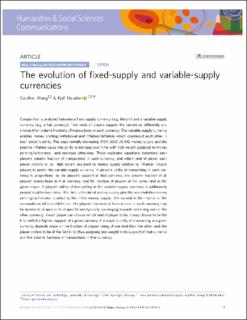| dc.contributor.author | Wang, Guizhou | |
| dc.contributor.author | Hausken, Kjell | |
| dc.date.accessioned | 2022-04-21T06:58:39Z | |
| dc.date.available | 2022-04-21T06:58:39Z | |
| dc.date.created | 2022-03-25T19:46:30Z | |
| dc.date.issued | 2022-04 | |
| dc.identifier.citation | Wang, G., Hausken, K. (2022) The Evolution of Fixed-Supply and Variable-Supply Currencies. Humanities & Social Sciences Communications, 9, 137 | en_US |
| dc.identifier.issn | 2662-9992 | |
| dc.identifier.uri | https://hdl.handle.net/11250/2991797 | |
| dc.description.abstract | Competition is analyzed between a fixed-supply currency (e.g. Bitcoin) and a variable-supply currency (e.g. a fiat currency). Two kinds of players support the currencies differently and choose their volume fractions of transactions in each currency. The variable-supply currency enables money printing/withdrawal and inflation/deflation, which counteract each other in each player’s utility. The exponentially increasing 1959–2021 US M2 money supply and the positive inflation cause this utility to increase over time with high weight assigned to money printing/withdrawal, and decrease otherwise. Three replicator equations determine each player’s volume fraction of transactions in each currency, and which kind of player each player prefers to be. High weight assigned to money supply relative to inflation induces players to prefer the variable-supply currency. A player’s utility of transacting in each currency is proportional to the player’s support of that currency, the volume fraction of all players’ transactions in that currency, and the fraction of players of the same kind as the given player. A player’s utility of transacting in the variable-supply currency is additionally proportional to two ratios. The first is the initial money supply plus the accumulative money printing/withdrawal divided by the initial money supply. The second is the inverse of the accumulative inflation/deflation. The players’ fractions of transactions in each currency may be inverse U shaped or U shaped before typically converging towards preferring one or the other currency. If each player can choose which kind of player to be, it may choose to be the kind with the highest support of a given currency. If a player’s utility of transacting in a given currency depends more on the fraction of players being of one kind than the other kind, the player prefers to be of the first kind, thus assigning less weight to its support of that currency and the volume fractions of transactions in that currency. | en_US |
| dc.language.iso | eng | en_US |
| dc.publisher | Springer Nature Switzerland AG | en_US |
| dc.rights | Navngivelse 4.0 Internasjonal | * |
| dc.rights.uri | http://creativecommons.org/licenses/by/4.0/deed.no | * |
| dc.subject | valuta | en_US |
| dc.subject | kryptovaluta | en_US |
| dc.subject | spillteori | en_US |
| dc.title | The Evolution of Fixed-Supply and Variable-Supply Currencies | en_US |
| dc.title.alternative | The Evolution of Fixed-Supply and Variable-Supply Currencies | en_US |
| dc.type | Peer reviewed | en_US |
| dc.type | Journal article | en_US |
| dc.description.version | publishedVersion | en_US |
| dc.rights.holder | © The Author(s) 2022 | en_US |
| dc.subject.nsi | VDP::Samfunnsvitenskap: 200::Økonomi: 210 | en_US |
| dc.source.volume | 9 | en_US |
| dc.source.journal | Humanities & Social Sciences Communications | en_US |
| dc.identifier.doi | 10.1057/s41599-022-01150-3 | |
| dc.identifier.cristin | 2012658 | |
| dc.source.articlenumber | 137 | en_US |
| cristin.ispublished | true | |
| cristin.fulltext | original | |
| cristin.qualitycode | 1 | |

